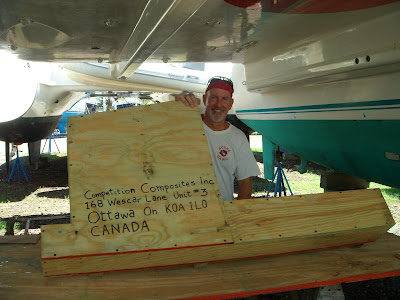We’ve been in the boatyard for a few weeks, which is about what it takes in island time to get anything done “jus now”. It took us about a week to muddle through the options for rebuilding the rudder, which were shaping up to look like:
- Have the rudder rebuilt locally
- Ship the rudder to a knowledgeable company who would rebuild the rudder on our old stock, using the broken rudder as a pattern
- Have a new rudder built from the original plans
The quote from the boatyard for a local rebuild was disappointing, nearly twice as much as option two. After much emailing, Skype, and marked up digital photos, we wound up with a hybrid of two and three. One of the potential vendors, Competition Composites in Ottawa, Canada, got the original plans from German Frers Engineering (German is the designer of Troubadour, Beneteau was the builder) and gave us the option of using our original rudder post or building a new one. After a few shipping quotes, it looked like we could save a considerable amount of money instead of having a new stainless shaft built.
 |
| Prying apart the foam and fiberglass to extract the rudder post. The boatyard set us up under a huge catamaran so we could get some shade. |
 |
| Scraping the waterlogged foam from the post extension |
 |
| Rudder shaft in the crate |
 |
| Ready to ship |
One of our bilge pumps had a large diameter hose designed to pump water overboard near the waterline. This is good, as large diameter hose has low resistance, and an outlet near the waterline means it doesn’t have to pump it uphill very far, so it makes for an efficient pump. When you live on a boat, you sleep better when you know you have a bilge pump that can pump out lots of water if necessary. You also know, or learn very quickly, that everything has a trade off. Monohull sailboats, when sailing, heel. In our case, when on a starboard tack and heeling to port, it puts the bilge pump exit underwater. That makes the exit an entrance, and water coming into the boat is bad. Since the installers weren’t insane, and did put a check valve into the line, not much water comes in, but I feel that a good portion of the water I find in the bilge after a sail is due to water backflooding from the exit hose, past the check valve, through the bilge pump, and into the bilge. I decided that eliminating water coming into the boat is preferable to a future, possible, hopefully-never-needed efficiency.
The good news is that what was probably the original thru-hull fitting is still located on the transom (back end of the boat), which doesn’t submerge when the boat heels. I can re-route the bilge pump hose there, and won’t need a check valve, which will recoup some efficiency. In the meantime, I have ground a crater into the fiberglass around each of the holes left by the fittings I removed, and am in the process of adding layer after layer of fiberglass cloth to fill the craters. This has been filling(!) my boatyard days, which have been quite short to date.
While I wait for the epoxy on the fiberglass cloth to set, my motivation wanes as the sun gets high in the sky and the deck becomes too hot to walk on. Afternoons in the apartment on the top of the hill with a cool breeze are much preferable to working in the boatyard. I don’t think we’ll get all our work accomplished in the time available if I continue to work this way, but it’s nice while it lasts!
For an update to our rudder story, see this post: New Rudder Tale
For an update to our rudder story, see this post: New Rudder Tale
Fairwinds


No comments:
Post a Comment